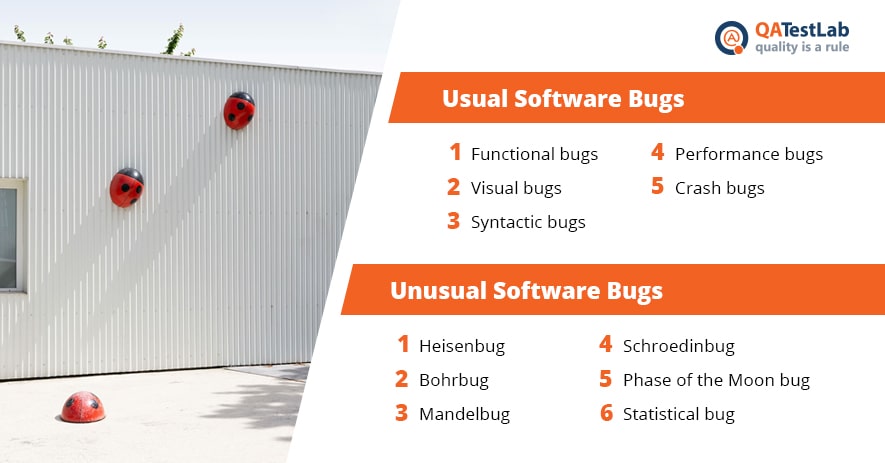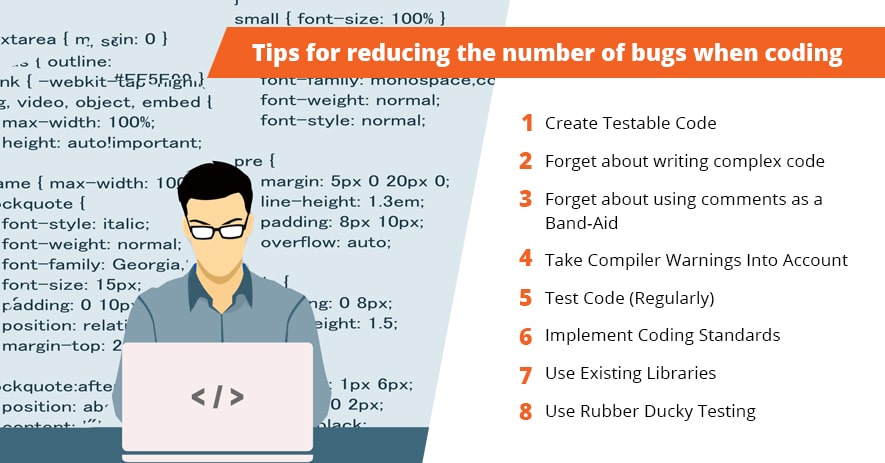- QATestLab Blog >
- QA Basics >
- Know Your Enemy in Face: Types of Bugs & Ways to Prevent Them
Know Your Enemy in Face: Types of Bugs & Ways to Prevent Them

Your software works fine, and then suddenly, start to display one error after another? Why does it happen? The reason is apparent – you encounter a software bug. But what does it mean? Most importantly, how to prevent bugs and ensure the highest quality for your software? Today, QATestLab answers all these questions and spill the beans on software bugs. This article will be valuable for everyone to find out about possible bugs and know your enemy in the face.
What Types of Software Bugs Can You Encounter?
Bugs are dangerous. You can put lots of effort into developing a perfect product, but everything will be spoiled in one second because of one small error. That’s what the real essence of bug is. It is mainly erroring that you don’t even expect to happen. These errors, in turn, have different faces. Some of them happen more often, and some of them not. Nevertheless, bugs still remain a big problem that is worth exploring. So what are the types of bugs?

To the greatest extent, there are two kinds of bugs: usual bugs and those that happened very rarely and are the unusual bugs. Let’s start finding out the meaning of the first group, namely the typical bugs that occur very often:
- Functional bugs. These are failures in the general workflow of the app caused by improper system behavior or enabled product features.
- Visual bugs. Layout and user interface distortions or mistakes.
- Syntactic bugs. The grammar mistakes or misspelled words and sentences used in product GUI. Such errors can be connected with the localization procedure.
- Performance bugs. Problematic slowness, hanging, or sluggish interface.
- Crash bugs. The unexpected failure of the program to work and function at all.
The five types described above are general terms that may include other variations of bugs. Of course, this list does not end there. Nothing is so simple, especially when it comes to bugs. That’s why there is another group of bugs that QA specialists call a nightmare. What’s so unusual about them? Let’s figure it out:
- Heisenbug. This weird name comes from Heisenberg’s Uncertainty Principle in quantum physics. The greatest trick of this bug is that it disappears or alters its behavior when one attempts to fix it.
- Bohr Bug. The name comes from the atom model developed by Niels Bohr. This unusual error replicates itself many times and manifests reliably under a possibly unknown but well-defined set of conditions.
- Mandelbug. This type of bug derives from the Mandelbrot set. Usually, it underlines causes that are so complex and obscure to predict. Mandelbug has chaotic behavior.
- Schroedinbug. Taking this name from the Schroedinger’s Cat, this catastrophic bug manifests itself unexpectedly and stops the entire program.
- Phase-of-the-moon-bug bug. This bug really depends on the phase of the moon. It all started with the MIT program, which was supposed to determine the phase of the moon through LISP, but then it affected another function – text input. For instance, the length of the first line of the message starts to depend literally on the phase of the moon.
- Statistical bug. This bug can be detected only in aggregates and usually affect the code supposed to produce some random and pseudo-random output.
Bugs have different faces, and very often, you don’t even guess about their existence. That’s why there is a software testing that can detect all the imperfections of application, and deliver product owners confidence of correct functionality for all the users. But how to catch all those bugs?
Secrets on Reducing Software Bugs (For Developers)
Both usual and unusual bugs can be detected during different types of software testing, for example, functional, system, integration checking types, and more. Apart from this, there are some of the secrets of catching all those bugs faster. Today, QATestLab will share bits and pieces on them:

- Create Testable Code. Even while writing code you can think in advance and check it. Test your code once you complete it and see whether it is able to pass the test right from the start.
- Forget about writing complex code. Simplicity is the key. Aim for writing simple readable code, and don’t overload it with complex snippets.
- Forget about using comments as a Band-Aid. Use comments when you need it.
- Take Compiler Warnings Into Account. Take into account all the compiler warnings.
- Test Code (Regularly). Test, test, and test again!
- Implement Coding Standards. Learn about coding standards that help to write better code. For instance, if you are coding on Python you can use PEP8, or PEP 20.
- Use Existing Libraries. Don’t waste your time doing what is already done, use existing libraries and save your nerves.
- Use Rubber Ducky Testing. This is an interesting approach to debating through conditional communication with a duck. Imagine that there is a duck near you, to which you need to explain each line of your code and make it clear.
These simple yet powerful techniques will help you to boost your program on a higher level and avoid a good half of software bugs.
……………………………
If your products are requiring testing, we are ready to hedge your team and ensure the high quality. We are participating in the life of the product, and do our work with a passion for your success. Let’s make great products together.
Visit our blog to read more about QA & testing. Feel free to contact us for collaboration.
Learn more from QATestLab
Related Posts:
- 4 Ways to Find the One Hundred Percent Bug
- The Most Unusual Bugs
- Who to Blame for Software Defects in Production?
About Article Author
view more articles
has more than 2-year experience in blogging and copywriting, copyediting and proofreading of web content.
View More Articles






No Comments Yet!
You can be the one to start a conversation.